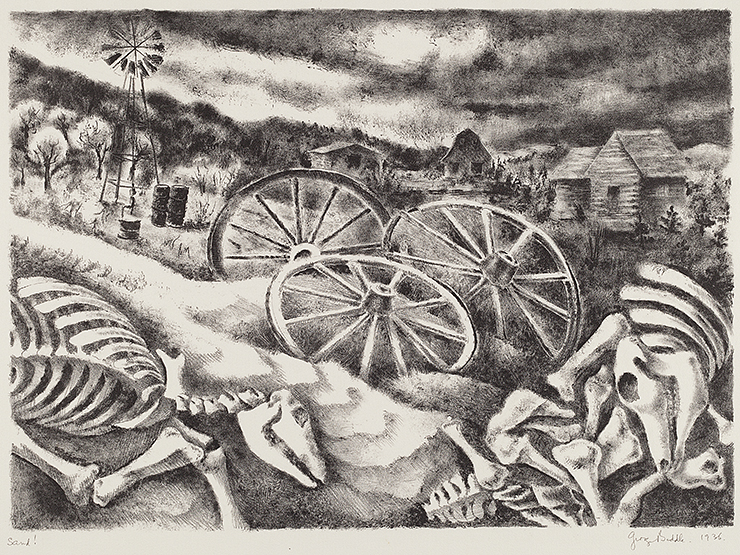EARLY MODERN ART ANALYSIS: THE INFLUENCE OF THE GREAT DEPRESSION
About The Great Depression
The Great Depression originated in the United States and began in 1929 through 1933. It was an economic shock that impacted the industrialized world, mainly Britain and Germany. World War I (WWI) left the country in the greatest debt. To combat the effects of the Great Depression, the Works Progress Administration (WPA) was established. It was a program that provided work for the unemployed during the severe depression because people wouldn't be able to afford art if they can't afford to eat. Artists, actors, and writers were hired by the Federal Art Project, a branch of the WPA, to create art for public spaces. Many artists during the Great Depression expressed their thoughts and emotions about the event through their artwork.
Untitled (Pensive Black Man), Seymour Fogel (1936)
Drought by Jacob Kainen (1935)
This piece was created in 1935 by Jacob Kainen, an American painter and printmaker. Jacob's purpose in this piece was to address the environmental devastation that occurred during the Great Depression, where agricultural workers and American Indians living on reservations were impacted the most. There are many clues in the piece, as well as the title, that gives the state of the environment. The slanted tree with no leaves indicates that the tree is dead, most likely because of drought. The farmer sitting down looks exhausted and burdened by the bad economy. The livestock in the far back are skinny and bony when they're supposed to be fat and healthy. Wagons are used to aid in harvesting crops, but it seems like there are no crops to harvest due to the wheels of the wagon being discarded by the shed. Linear lines are used to add depth to the piece, showing how much land has no crop. Lines are also used to show the strength of the tree while it a bit slanted. The piece relies a lot on the tone and shading. While there's no obvious lighting, you can see the shadow of the farmer in front of him, indicating that light is most likely shining behind him.
Sand! by Geroge Biddle (1936)
This piece was created in 1936 by George Biddle, an American painter. This piece is similar to Drought which was created by Jacob Kainen. The piece represents the aftermath of a sandstorm or fire that occurred on a farm. The skeletal remains of the livestock, possibly due to starvation, show that there's no life after the huge impact, and the discarded wagon wheels indicate that it's hard to "move" on from this event. Horizontal lines are used to enhance the storming clouds in the back. George's purpose in this piece was to create an image that reflected the aspects of American life. The great depression took place during this time and this piece reflects the hard times farmers had to encounter.
Thoughts and Discussion
The pieces I've chosen reflect on the event that was occurring at the time they were created, the Great Depression. Artists at this time were hired by the Federal Arts Project to continue creating art. Many styles of art were created during this time, including realism, abstract, and many more. The artists were able to express their thoughts and emotions through their artwork. I love how the artists had the same theme but all are from a different perspective. I would personally own all of the pieces that I've chosen for this blog since it's a great reminder of what our country has gone through. It doesn't have a good meaning behind them and isn't pleasant to look at but it's history.
Citations
Kindig, Jessie. “Culture and Arts during the Depression.” Culture and Arts in 1930s Washington State, 2009, depts.washington.edu/depress/culture_arts.shtml.
National Gallery of Art. “Art and the Great Depression.” Great Depression, 2023, www.nga.gov/learn/teachers/lessons-activities/uncovering-america/great-depression.html.





Thank you for sharing this. The influence of the great depression is a great subject on which I had no knowledge on. Untitled (Pensive Black Man) by Seymour Fogel stood out to me. The painting feels very realistic. The artist's use of light and shadow, as well as his attention to detail, adds depth and dimension to the painting. You can feel the emotion in the artwork. I like that this piece represents well the reality of the economy and social structure in 1930 at the time. The man painted seems overwhelmed which represents the tough times that came with the great depression.
ReplyDeleteWhat an explicit way to show a tragedy like the Great Depression by showing a ravaged farmland full of bones with a dark stormy sky overhead. The George Biddle work crams so much devastation into such a small frame. Every corner is filled with the results of the destructive storm, and sliding through the middle of the image is the sandy culprit.
ReplyDelete